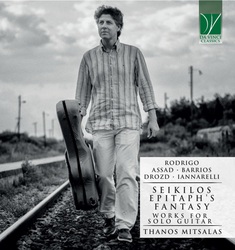“Seikilos Epitaph's Fantasy”
Thanos Mitsalas
“Seikilos Epitaph's Fantasy”
Works for solo guitar by
Assad, Barrios, Drozd, Iannarelli, Rodrigo
Track List:
Joaquin Rodrigo (1901–1999)
[7.28] 1 Toccata
Gerard Drozd (-)
Two Songs , op.172 (dedicated to T.Mitsalas)
[1.44] 2 “In a mood”
[3.17] 3 “Song”
Simone Iannarelli (b.1970-)
[10.12] 4 Fantasia in Re (dedicated to T.Mitsalas)
Agustin Barrios Mangoré (1885–1944)
[8.36] 5 Un Sueño en la Floresta
Gerard Drozd (-)
[3.10] 6 Kaleidoscopic Waltz no. 1 , op.167 (dedicated to T.Mitsalas)
[5.22] 7 Kaleidoscopic Waltz no. 2 , op.167 (dedicated to T.Mitsalas)
Sergio Assad (b.1952-)
[9.12] 8 “Seikilos Epitaph's Fantasy” (dedicated to T.Mitsalas)
CD available from : https://davinci-edition.com/product/c00416/
Recorded: Jan 16th 2019 (Tracks 4,8) , July 24th 2019 (Tracks 2,3,6,7)
Dec 28th 2019 (Tracks 1,5) – Cue Productions (cue.gr)
Program duration: [49.01”]
Sound Engineering/Editing/Mixing/Mastering: Yiannis Mavridis (cue.gr)
Photo credits: Nikos Chrysoulis
Guitar made by Thomas Humphrey - Spruce-top “Millennium” model - 1999
Strings: D'Addario Pro-Arte Carbon EJ46FF (trebles)
D'Addario Pro-Arte EJ46LP (basses)
!!!!Video Link on Youtube : https://youtu.be/M2A8GrYWbKs
About the project:
“Seikilos Epitaph's Fantasy” project explores a rich diversity in compositional styles, ideas, textures, sonorities and archetypes.
It could never become reality without the generous musical contribution of my good friends and great composers of our time Sergio Assad, Gerard Drozd and Simone Iannarelli.
Their inspiring adventurous music, along with J.Rodrigo's Toccata and A.Barrios' Sueño en la floresta, create a journey to a unique soundscape where time – as usually perceived- does not exist. The past blends with the present at a common space frame, while memories, stories, emotions, archetypes, emerge to the sunlight of an imaginary ideal time-space surface!
Seikilos (Assad's reference in this album) may sing and dream in the amazon's forests (native land of Barrios), Iannarelli's Fantasia with its intense rhapsodic-elegiac rhetoric can describe Troy's catastrophe and laments for Hector's death, while the unquite archaic Toccata (Rodrigo) unites with Drozd's poetic kaleidoscopic writing to recollect Bach's restless contrapuntal textures!
About the music:
Joaquin Rodrigo (1901-1999) was one of the greatest Spanish composers of the 20th century and one of the most prominent and innovative writers for guitar of all time. Although he was a non-guitar-playing composer, Rodrigo is one of a few mainstream writers who left a substantial legacy for the classical guitar repertoire.
Toccata is one of the best examples of Spanish virtuoso tradition on the guitar. Although it was composed back in 1933, remained in the drawer and had never been published or premiered until 2006. Since the time of its recent publication the piece started to gain the reputation -among guitarists- , to be one of the most difficult pieces to perform on the instrument. Toccata is clearly a virtuoso piece that responds to the language of the violin. It possesses an internal structure which, far from almost improvised liberty, responds to the sonata form utilized freely. Its perpetual fast motion in semiquavers combined with tight contrapuntal textures, as well as, broad virtuoso arpeggio sections which extend to the highest pitch register of the instrument, draw the attention of the listener.
Gerard Drozd - born in Gliwice, Poland, is a versatile composer, arranger, guitarist. As a composer has written more than 350 compositions including solo works, chamber music or concertos. His compositions have been appreciated by many well-known performers and have also been presented in more than 35 countries around the globe. Drozd's innovative writing techniques and idiomatic harmonic language have established him as one of the most renowned and respected composers in the guitar world nowadays.
Two Songs, Op. 172 were composed in 2017. The first one called "In a mood" derives from an improvisational aspect. Walking bass line makes this piece a little jazzy-swinging music, but all musical material is a kind of Drozd's individual musical language which he calls controlled case theory. The second piece just named "A Song" is very lirical, harmonically rich and follows according to the composer a kind of harmonical thinking named "kaleidoscopic harmony.” This song seems to tell a story. Calls to memories that are clearly heard, although it is only a musical-poetic creation born in the imagination.
Two Kaleidoscopic Waltzes op. 167 were also composed in 2017.
These two, in a sense, abstract waltzes in the very name indicate that they are composed on the basis of "kaleidoscopic harmony." This kind of composing gives enormous and constantly new potential for musical narration.
Simone Iannarelli (b.1970) is an Italian composer/guitarist born in Rome. During the past 15 years he has been living in Mexico where he teaches guitar at the music department of the University of Colima. His compositions are distinct from the extended use of scordaturas (varied tunings which apply more timbres to the sonorities of the instrument), their desctiptive -programmatic character and rich colorful textures. Simone is a prolific composer who explores the sound-colors of the instrument with a very personal idiomatic way. He has already achieved to be one of the most popular and respected composers of his generation.
Fantasia in Re consists of three main musical ideas:
A rapsodic opening "preludio" with extensive arpeggio’s elements that reminishes the renaissance concept of "tuning search". The subsequent second subject is built on a free contrapuntal form. This idea recalls the old ricercare. A third musical idea is included in the "Andante cantábile" where chordal writing makes contast with its vigorous pace and extensive use of modal harmony.
Agustín Pío Barrios (Paraguay, 1885- San Salvador, 1944). Many consider Barrios one of the greatest guitarists/composers of all time. In view of this fact, it is curious that his music laid undiscovered and unappreciated for over three decades after his death. Today Barrios' music is frequently performed by major concert artists and is admired by audiences world wide. One can appreciate in Barrios Mangoré a logical expansion of techniques defined by masters as Sor and Tárrega, carried to an even higher level of expressiveness and technical expertise.
The majestic tremolo piece Un sueño en la floresta is perhaps the most difficult and complex tremolo piece ever conceived for the guitar. The extremely romantic flavour and soaring melody belie the fact that the technical work required here is formidable, requiring extended left-hand stretches, long musical phrases, intricate independent movement of voices, a virtuosic cadenza and even a high C that requires a twentieth fret on the traditional nineteen-fret classic guitar (Barrios had the Brazilian luthier Romeo DiGiorgio make him a special instrument with twenty frets). Un sueño en la floresta elevates the technique of tremolo to a new level, carrying it well beyond the earlier Francisco Tárrega's Recuerdos de la Alhambra and Sueño. Barrios wrote this piece about 1917 and recorded it in 1929.
Brazilian guitarist/composer Sergio Assad (1952-) is undoubtedly one of the most important figures in the guitar world over the last 50 years. As a member of the famous Assad Duo he performed at every spot on the world map, while his recordings are point of reference for their unsurpassed artistry. Assad's compositions have a rich harmonic language, a great variation of moods and mostly vivid syncopated rhythms borrowed from the Brazilian music tradition. Most of his works clearly expand the technical limits of the guitar performance and consecutively are considered a "must" in the repertoire of highly skilled performers.
Seikilos Epitaph's Fantasy (2018) is based on the melodic material of the homonymous ancient Greek (Hellenistic Ionic) song. Seikilos epitaph is the oldest surviving complete musical composition, including musical notation, from anywhere in the world (dated approx.200 AD).
The song urges for a happy adventurous life:
While you live, shine
have no grief at all
life exists only for a short while
and Time demands his due.
Ancient Greeks believed that melody without rhythm is "disordered, inert and dark" while it was "vigorous, energetic and precise" when rhythm was added. Indeed, sometimes they characterized melody as the female element and rhythm as the male.
Assad really takes advantage of this and lifts off the theme crafting an adventurous Fantasia. Not only he varies the melodic motives, but also borrows plenty of different ancient Greek "Podes" (rhythmic patterns) to build a new descriptive "rhapsody". Rhythms like Iamb, Trochee, Paeon, Dochmius, Epitrite, Ionian, Tribrach, Enneasemos are masterfully elaborated to create a narration full of colorful moods and vivid images.






